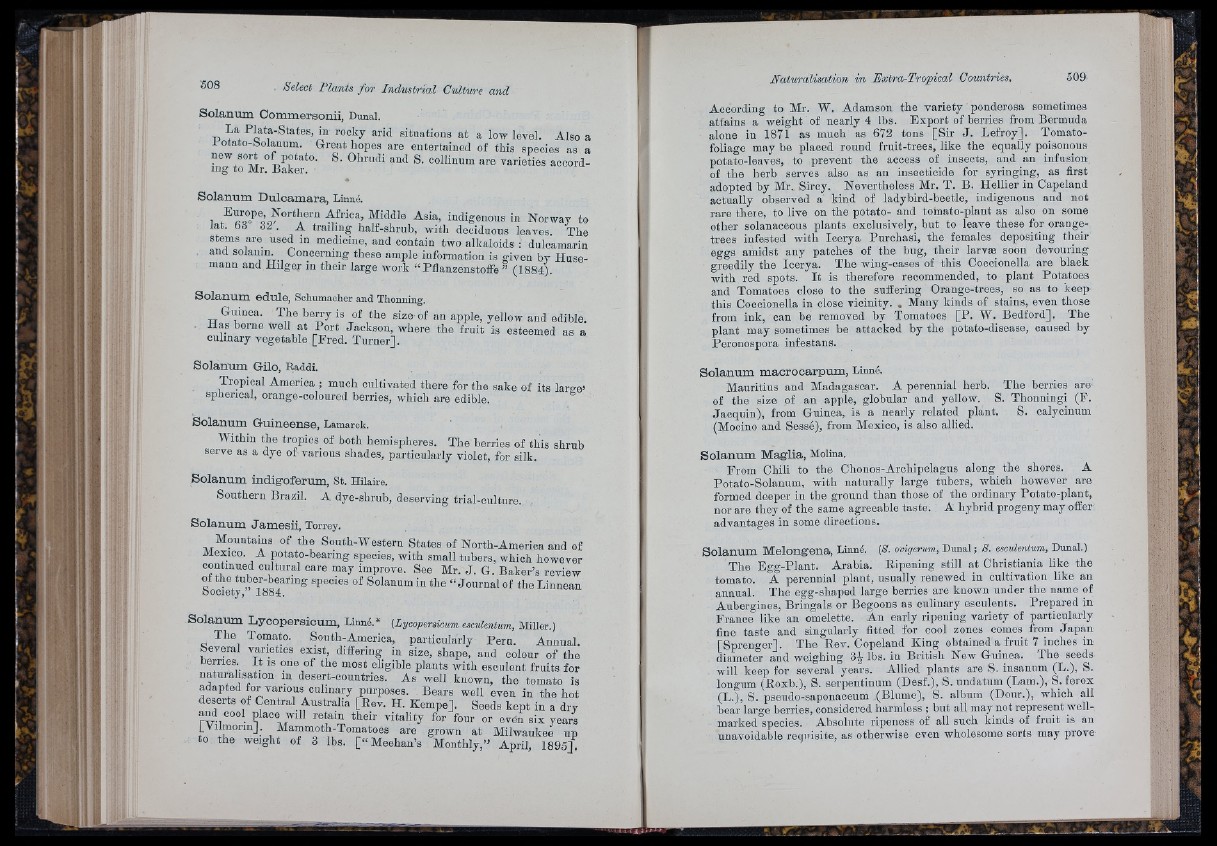
M I! '
r ii
if
il:
i )
t i
ì ’ il!
il i:S|!
Solanum Commersonii, Dunal.
La Plata-States, in rocky arid situations a t a low level. Also a
Potato-Solanum. Great hopes are entertained of this species as a
new sort of potato. S. Ohrudi and S. collinum are varieties accord-
lug to Mr. Baker.
Solanum Dulcamara, Linné.
, indigenous in Norway to
iat. 63 3 .,. A trailing half-shrub, with deciduous leaves. The
stems are used in medicine, and contain two alkaloids : dulcamarin
and solamn Concerning these ample information is given by Huse-
mann and Hilger in their large work “ Pflanzeustoffe ” (1884).
Solanum edule, Schumacher and Thonning.
Giiinea. The berry is of the size of an apple, yellow and edible.
. Has borne well at P o rt Jackson, where the fruit is esteemed as a
culinary vegetable [Fred. Turner].
Solanum Gilo, Raddi.
Tropical America ; much cultivated there for the sake of its large*
spherical, orange-coloured berries, which are edible.
Solanum Guineense, Lamarck.
Within the tropics of both hemispheres. The berries of this shrub
serve as a dye of various shades, partioularly violet, for silk.
Solanum indigoferum, St. Hilaire.
Southern Brazil. A dye-shrub, deserving trial-culture.
Solanum Jamesii, Torrey.
Mountains of the South-Western States of North-America and of
Mexico. A potato-bearing species, with small tubers, which however
continued cultural care may improve. See Mr. J . G. Baker’s review
Society species of Solanum in the ‘^Journal of the Linnean
Solanum Lycopersicum, Linné.* (Lycopersicum esoulentum, Miller.)
The Tomato. South-America, particularly Peru. Annual.
Several varieties exist, differing in size, shape, and colour of the
berries._ I t is one of the most eligible plants with esculent fruits for
naturalisation in desert-countries. As well known, the tomato is
^ a p te d for various culinary purposes. Bears well even in the hot
deserts of Central Australia [Rev. H. Kempe]. Seeds kept in a dry
cool place will retain their vitality for four or oven six years
[V i^ o rm ] . Mammoth-Tomatoes are grown a t Milwaukee up
to the weight of 3 lbs. [ “ Meehan’s Monthly,” April, 1895])
According to Mr. W. Adamson the variety ponderosa sometimes
attains a weight of nearly 4 lbs. Export of berries from Bermuda
alone in 1871 as much as 672 tons [S ir J . Lefroy]. Tomato-
foliage may be placed round fruit-trees, like the equally poisonous
potato-leaves, to prevent the access of insects, and an infusion
of the herb serves also as an insecticide for syringing, as first
adopted by Mr. Sircy. Nevertheless Mr. T. B. Hellier in Capeland
actually observed a kind of ladybird-beetle, indigenous and not
rare there, to live on the potato- and tomato-plant as also on some
other solanaoeous plants exclusively, but to leave these for orange-
trees infested with Icerya Purchasi, the females depositing their
eggs amidst any patches of the bug, their larvæ soon devouring
greedily the Icerya. The wing-cases of this Coccionella are black
with red spots. I t is therefore recommended, to plant Potatoes
and Tomatoes close to the suffering Orange-trees, so as to keep
this Coccionella in close vicinity. , Many kinds of stains, even those
from ink, can be removed by Tomatoes [P . W. Bedford]. The
plant may sometimes be attacked by the potato-disease, caused by
Peronospora infestans.
Solanum macrocarpum, Linné.
Mauritius and Madagascar. A perennial herb. The berries are
of the size of an apple, globular and yellow. S. Thonningi (F.
Jacquin), from Guinea, is a nearly related plant. S. calycinum
(Mooino and Sesse), from Mexico, is also allied.
Solanum Maglia, Molina.
From Chili to the Chonos-Archipelagus along the shores. A
Potato-Solanum, with naturally large tubers, which however are
formed deeper in the ground than those of the ordinary Potato-plant,
nor are they of the same agreeable taste. A hybrid progeny may offer
advantages in some directions.
Solanum Melongena, Linné. (S. ovigerum, Dnnal; S. esculentum, Dunal.)
The Egg-Plant. Arabia. Ripening still a t Christiania like the
tomato. A perennial plant, usually renewed in cultivation like an
annual. The egg-shaped large berries are known under the name of
Aubergines, Bringals or Begoons as culinary esculents. Prepared in
France like an omelette. An early ripening variety of particularly
fine taste and singularly fitted for cool zones comes from Japan
[Sprenger]. The Rev. Copeland King obtained a fruit 7 inches in
diameter and weighing SJ lbs. in British New Guinea. The seeds
will keep for several years. Allied plants are S. insaiuim (L.), S.
longum (Roxb.), S. serpentinum (Desf.), S. undatiim (Lam.), S. ferox
(L.), S. psendo-saponaceum (Blume), S. album (Dour.), which all
bear larue berries, considered harmless ; but all may not represent well-
marked species. Absolute ripeness of all such kinds of fruit is an
unavoidable requisite, as otherwise even wholesome sorts may prove